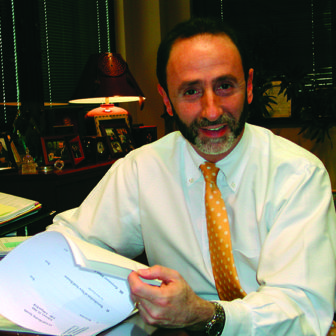Want to keep youth out of the juvenile justice system?
Maybe the best way is not to lock them up in the first place.
A new report that examines innovative efforts to reduce recidivism across the country recommends that authorities focus more effort on youth whose behaviors pose a threat to public safety — and to stop pouring those who don’t into the justice system.
The report, produced by the the Council of State Governments Justice Center and Georgetown University’s Center for Juvenile Justice Reform, lays out six strategies the authors say can reduce the number of teens who become repeat offenders. It’s the product of interviews with four dozen people in the field — judges, administrators, probation officers, academics and advocates — about practices that they’ve found improve those outcomes.
“It’s an affirmation of a number of things going on in a piecemeal fashion that we think should be put together in a comprehensive way,” said co-author Shay Bilchik, director of Georgetown’s Center.
The recommendations were the focus of a Georgetown conference that convened Monday in Washington. While juvenile crime and custody rates have plummeted since their peak in the mid-1990s, recidivism is still “unacceptably high,” the report said.
Status offenses, technical violations

Shay Bilchik
The list of strategies starts with decriminalizing status offenses — charges like truancy or breaking curfew that only apply to minors — and diverting youth arrested for other offenses away from the courts if they’re considered low risks to public safety.
The authors also recommend dropping the practice of hauling youth back into court for technical probation or parole violations. Up to a quarter of teens in detention are held for violating the conditions of their supervision, the report notes.
“These technical violations needlessly clutter court dockets, preventing judges and attorneys from focusing on youth who commit serious and violent offenses,” the report said. That means those most likely to commit new crimes “often don’t receive the services needed to reduce their likelihood of future offending.”
For reform advocates like Marsha Levick, the deputy director of the Philadelphia-based Juvenile Law Center, the report “says everything we would want it to say.”
“It appears to effectively strike a balance between intervention and expenditure of resources on youth whose conduct legitimately poses a threat to public safety and whose conduct therefore warrants an investment of community resources, while at the same time minimizes intervention with youth facing status offenses,” Levick said, adding, “We hope we will see these ideas and strategies spread out around the country.”
The authors urge community leaders to rethink not only who gets locked up but how those who aren’t are supervised. Probation or parole terms should be geared toward restorative justice, with offenders directly making amends for their crimes, the authors write. And violations of those terms should be met with gradually increasing responses that are “swift, certain, consistently applied, and proportionate,” not just being threatened with custody.
Other recommendations
“Our hope is the paper will create an opportunity for people to think about what these ideas are,” said Bilchik, who served as head of the Justice Department’s Office of Juvenile Justice and Delinquency Prevention during the Clinton administration. “How can I advance these ideas in my jurisdiction if I’m at a county level or state level? What could I be able to do differently following the guidance provided in this document?”
The other recommendations include:
- Retooling probation programs toward making positive changes in young people’s behavior, giving them and their families “easily understood goals, objectives, and next steps.”
- Building up standards for juvenile court judges and lawyers to produce “a dedicated cadre” of specialists. In many jurisdictions, juvenile court is considered an early-career stepping stone, so judges and lawyers lack the knowledge and skills to produce better results — or the interest to make improvements.
- Focusing services on building strong connections to positive adult, community or peer support. Without those supportive relationships, improved skills or behavior “are fleeting and unlikely to have a long-term impact on public safety.”
- Using data and analytics to gauge outcomes — not only to keep track of the youth, but to hold players in the system accountable.
How to make the changes

Juvenile Law Center
Marsha Levick
Most of the proposals are likely to be attainable under current funding, Bilchik said, though some counties or agencies might need more money for computer or data systems.
“They are things that you can implement by changing policies and practices and conforming those policies and practices to what we’re talking about in the paper,” he said.
Steven Teske, a juvenile court judge in Clayton County, Georgia, with a national profile, called the report a “great document” that reflects what he’s seen in his suburban Atlanta courthouse.
“I am glad to see this publication, and I hope more local systems take advantage of these strategies,” Teske said.
All six recommendations have been used in his county since 2003, resulting in a 71 percent drop in delinquency filings and a 46 percent drop in felony cases, he said. Court officials try to match kids to programs that can address their needs, and keep them under community supervision rather than in custody when possible. Technical probation violations are filed only when a child can’t be found — and judges can allow the kids to be returned to their parents if they’re picked up.
Political climate a factor
Levick said changes to probation practices and the call to decriminalize status offenses may be a tough sell. Prosecutors may be able to make decisions at the local level to implement those, “but it may also require legislative or regulatory changes,” she said.
“Certainly political will is an element of this reform agenda, and in the absence of that, it will be difficult to advance it,” she said. And changing probation officers’ jobs toward something more closely resembling social workers’ is “not just a question of political will, but of stakeholder will.”
“It’s really upending an approach to doing a particular task or delivering a service within the juvenile justice system that’s very different from how it has traditionally been done,” Levick said. “Any time we talk about a culture shift, there is inertia and there is resistance.”
And Teske said getting rid of probation or parole violations may be a sticking point for elected officials as well.
“Our society is so entrenched in punishment that it is hard for some to separate the trees from the forest and wrap their heads around a strength-based approach versus the traditional punitive, or deficit-based, approach,” he said. Politicians don’t want to be seen as being “soft” on crime, “and they cave — never mind that it actually works.”
“Our political system doesn’t support always doing what is right,” Teske said.
This story has been updated.
